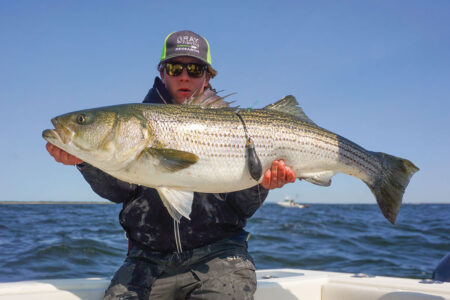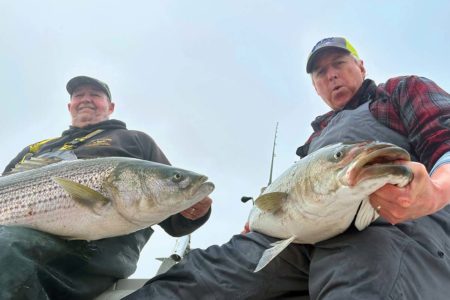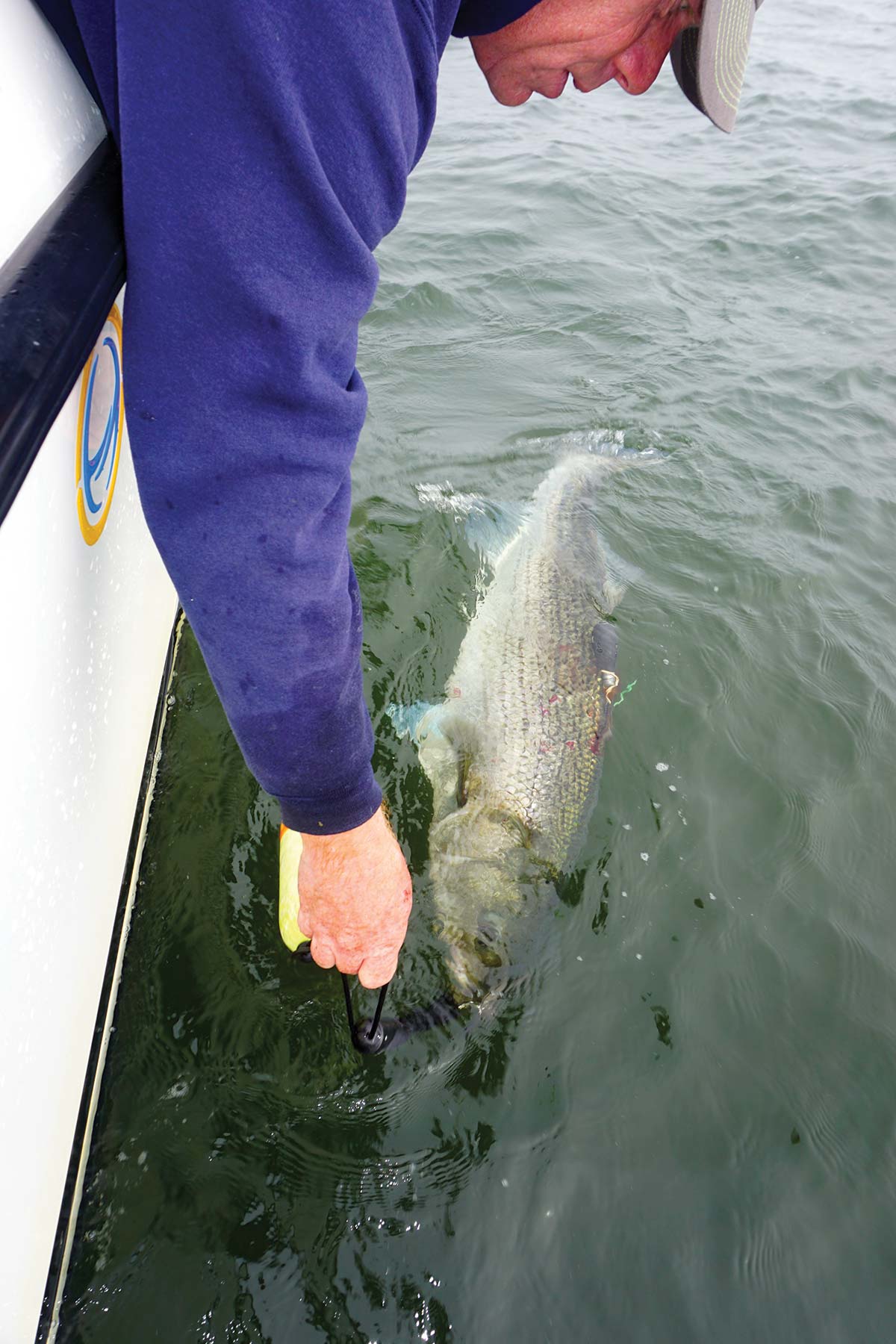
The third and final “SAT” tag in the 2020 Northeast Striped Bass Study provides more startling offshore results!
If the shortest distance between two points is a straight line, why then must we always assume that striped bass follow a coastal migration path that constantly keeps these fish in close proximity to land?
That of course may be one of the biggest takeaways of all from two years’ worth of satellite tagging work with the Northeast Striped Bass Study. Launched in 2019 as a partnership with The Fisherman Magazine and Gray FishTag Research, the study began with two satellite tagged fish in the lower Hudson River and continued through 2020 with two tagged fish off of Sandy Hook in the spring and a third on July 3 off Montauk, NY.
As reported in the November edition of The Fisherman, the first two fish of 2020 that our team named Cora and Rona were caught around Memorial Day roughly 2-1/2 miles east of Sandy Hook, NJ aboard Chuck Many’s Tyman and fitted with “pop-off” satellite tags. Developed by Wildlife Computers, the $5,000 MiniPSAT devices incorporate light-based geolocation for tracking, time-at-depth histograms for measuring diving behavior, and a profile of depth and temperature.
About a month after Cora and Rona – each over 45 inches in length – were caught and released, the Northeast Striped Bass Study team headed out to Montauk to join Capt. Savio Mizzi aboard Fishooker charters in search of our third big fish of the 2020 season. With The Fisherman’s Mike Caruso and Fred Golofaro onboard for the July 3rd trip, the team stuck a 46-inch striper which was appropriately named Independence for the holiday weekend.
“We were looking for a fish over 45 inches and this one measured out at 46 so we decided to go with her rather than hold out for an even bigger fish,” said Golofaro, adding “We moved around between Great Eastern, the Porgy Hump and Pollock Rip, where Savio hooked Independence.”
Programmed with an electrical charge to pop off after four months, the team waited with “baited” breath for the results. Truth be told, the MiniPSAT devices affixed to Cora and Rona disengaged a bit earlier than hoped, but considering the devastating alternative to an early disengagement being no return at all, the Northeast Striped Bass Study team was excited. But right on schedule, Independence’s tag began to ping the Argos satellite on November 3, with the tag appearing to upload from somewhere along the shores of Delaware Bay near the small fishing town of Fortescue, NJ.
And that’s where our straight line discussion begins!
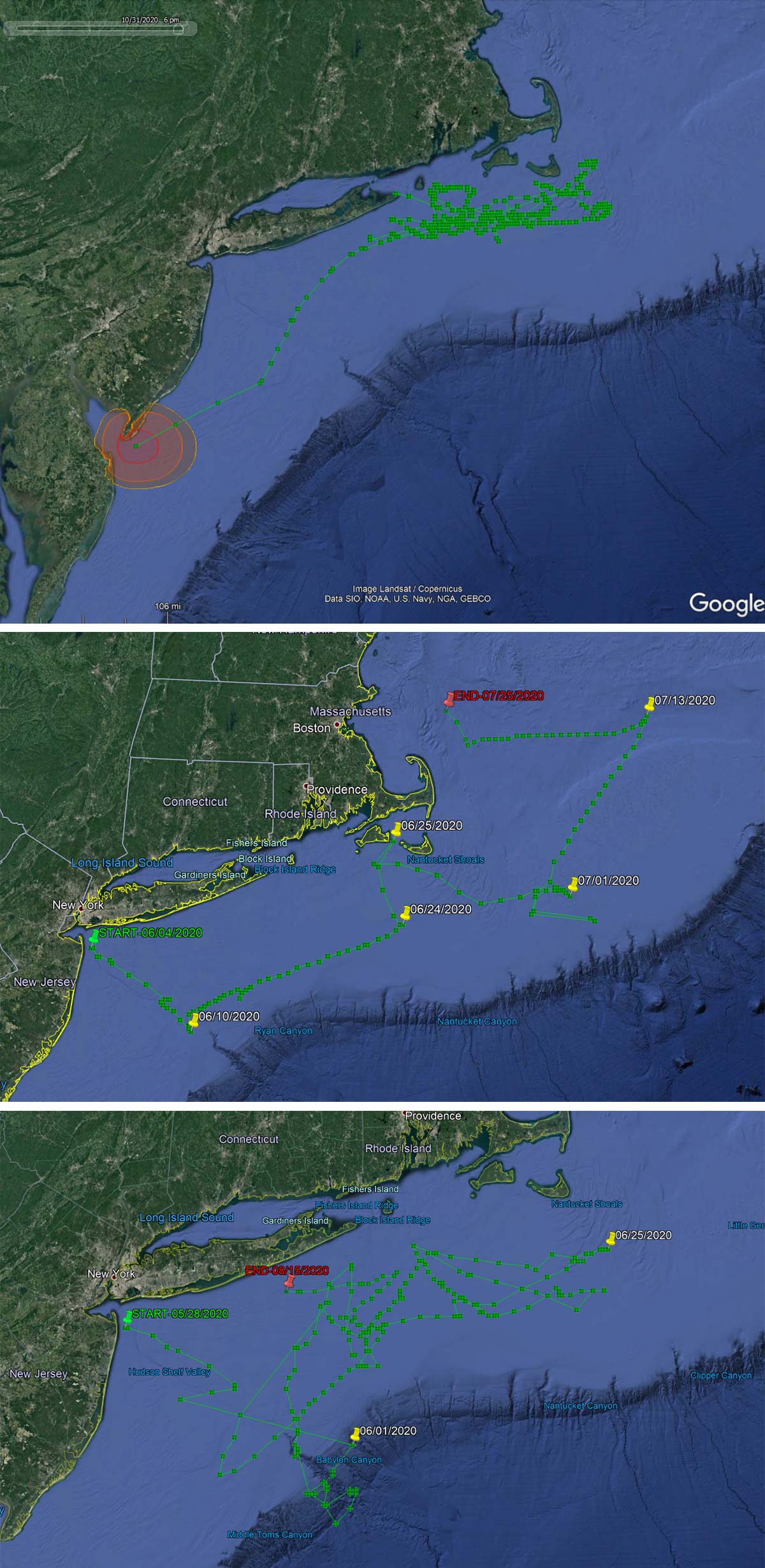
Nantucket Sleigh Ride
According to the data uploaded to the Argos satellite from the MiniPSAT device, soon after her initial catch and release, Independence swam in a southeasterly direction into depths from 100 to 180 feet of water outside of the three-mile-line. She eventually tracked north up into what appears to be the Block Island Wind Farm area before circling around the area of The Gully, an area popular for shark fishermen southeast of Block Island.
Looking at her tracking chart, carefully plotted by the team from Gray FishTag Research, Independence spent the majority of her summer in federal waters, ultimately making her way east towards Nantucket Shoals. It should be noted that this particular area was also one of the preferred locations for both Cora and Rona tagged a month earlier. Whether these three fish were in similar areas as Independence prior to July 3 is impossible to know; what we do know is that Cora and Rona traveled well offshore after their capture and release off the Jersey Shore. But in chart overlays compiled by Gray FishTag Research, the three big fish do find some summer affinity to Nantucket Shoals.
“I do know by looking at the video track that Independence spent most of her time in that area before heading south on or around October 26 before the tag’s programmed release date of November 2,” said Roxanne Willmer at Gray FishTag Research. But these three big stripers seemed to find interest in this vast area off Nantucket Island, MA known through our nation’s maritime history as one of the Northeast’s biggest ship graveyards.
According to Toby Lapinksi, the New England edition managing editor of The Fisherman, Nantucket Shoals has also become a perennial hotspot for doormat fluke in the summer and is unique in its ability to hold fish. “One of the theories as to why it is so good for fluke is that the bottom composition prevents draggers from working over it whereas they can and do hammer every other inch of fluke bottom in New England on a daily basis,” Lapinski said.
“Being all sand that is constantly shifting, it both holds bait like sand eels and is too uneven to get commercially fished by anything other than hook and line,” said Lapinski, adding “Perhaps this combo is also attractive to striped bass.”
What’s clear from the satellite tracking is that the three big fish tagged in 2020 during the Northeast Striped Bass Study did not spend much time inside the three-mile-line where they’d be legally accessible to anglers. While Cora, Rona and Independence were caught inside the line at different points of the season, their summer travels well offshore are quite similar to the two fish named Freedom and Liberty that were tagged during the 2019 study. Whether brought about due to bait patterns or climate change, or if it’s part of a big fish’s natural tendencies that have yet to be identified, remains to be seen.
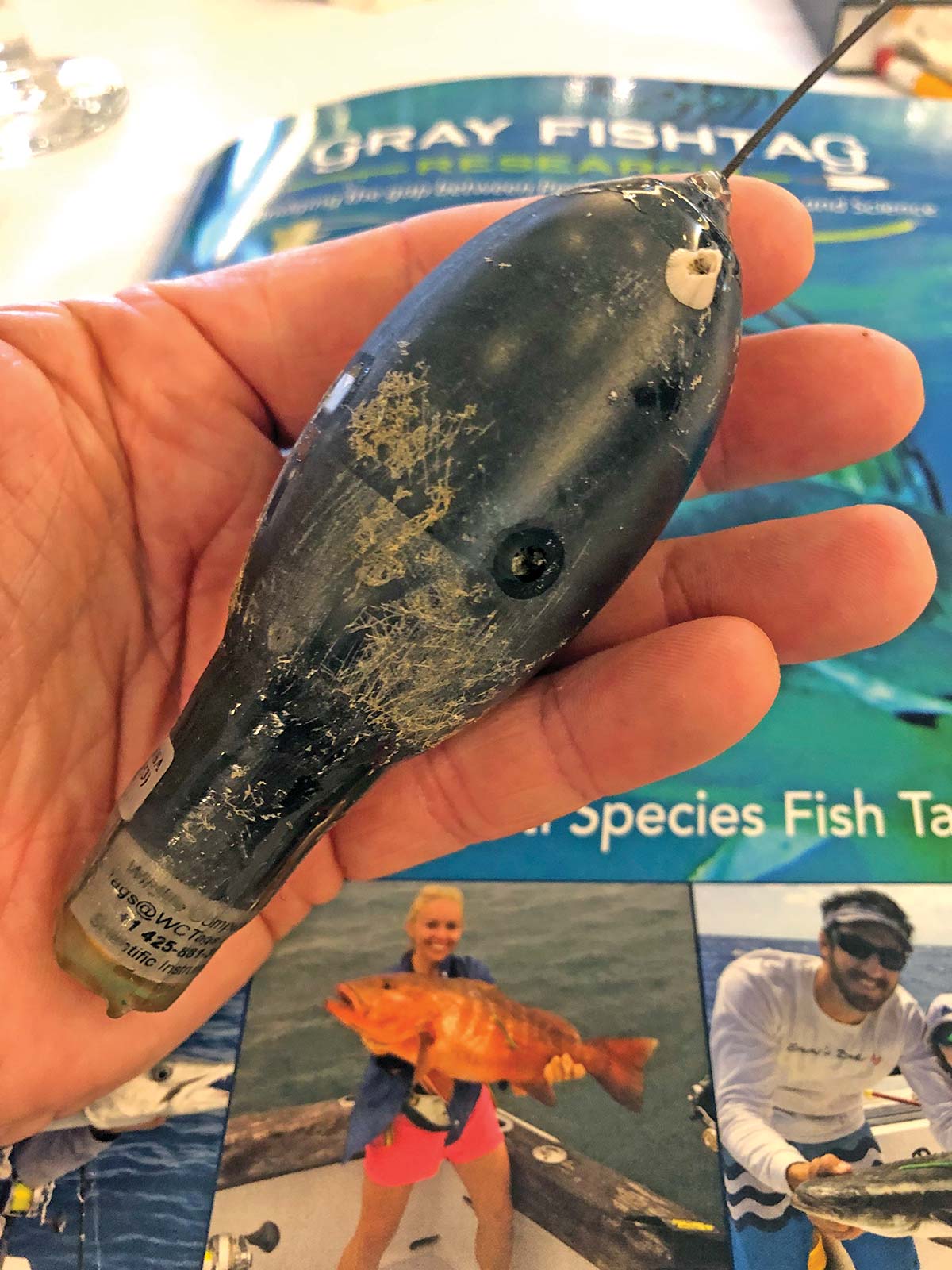
A Coastal Migration
Outside of summer flounder, the iconic striped bass annually appears as the number one most sought after fish by readers in The Fisherman’s readership surveys. It’s also the subject of our nation’s very first conservation law when the Massachusetts Bay Colony forbade the use of striped bass as fertilizers back in 1639. Roughly 50 years later, three descendants of that original Massachusetts Bay Colony – whaling brothers Thomas, Shamgar and Benjamin Hand – left their home at East Hampton near Montauk and set sail for Cape May, NJ where they’d settle along the shores, Thomas on the Delaware Bay side and Shamgar and Benjamin on the ocean side.
“Local lore says that the first whaler-yeomen here were hunting whales seasonally for decades before they were able to purchase plantations here in the 1690s,” said Cape May historian Jamie Hand, who noted that the early whalers were surely skilled enough to sail straight southwest to Cape May from the Hamptons. Whether those original whalers hugged the beaches or sailed directly across in a straight line is unknown; more than likely the Hands followed the whales. Regrettably for 21st century striper fishermen who annually await the arrival of large stripers along the beaches in between, Independence would remain offshore, perhaps following the bait, tuna and whales as well!
After seemingly spending some time on the prowl between the Ranger Wreck and the Coimbra Wreck offshore of Long Island, an area ripe with life and outstanding tuna action during the summer of 2020, the large striper tracked in a more southerly direction down through the approximate area of the Glory Hole and the Fingers some 30 to 40 miles off the Jersey Shore before taking a more southwesterly path from somewhere off Brigantine, across Avalon Shoals, to the entrance to Delaware Bay just a few miles off Cape May.
While the first uploads from Independence’s MiniPSAT device to the Argos satellite in early November came from inside Delaware Bay in the area around Fortescue, whether that big striper spent much time in the traditional November hotspots like the Cape May Rips or Tussey’s Slough is hard to determine. However, in The Fisherman’s South Jersey reports on November 1, Hands Too Bait and Tackle in Cape May reported that while angling participation was low that week due to poor weather, one 50-inch striper was caught and released from the beach in Cape May by a surfcaster baiting with surf clam.
It should be noted of course that all the MiniPSAT tagged stripers also have a green Gray FishTag Research streamer tag. Hopefully, one day, we’ll hear more about the travels of these big fish.
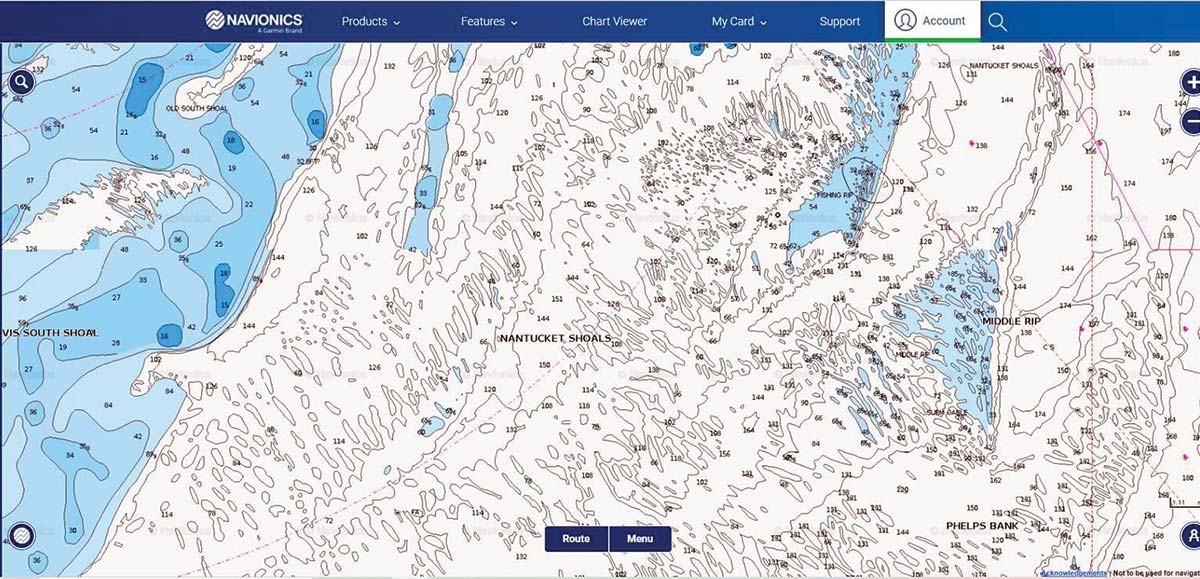
But they don’t do that?!
There’s a big difference in “what we know” about striped bass and “what we think we know.” While much of the latest research out of NOAA Fisheries has focused on the near-coastal migration, some historic data indicates that offshore travels are not something new. Soon after publishing the results of Cora and Rona in The Fisherman’s November, 2020 edition, we received an email from John A. Tiedemann, Assistant Dean of the School of Science at Monmouth University in New Jersey. “In 2002 the Smithsonian Press published a fantastic update of Bigelow and Schroeder’s ‘Fishes of the Gulf of Maine’ edited by Bruce Collette and Grace Keein-MacPhee,” Tiedemann noted, adding “It is a fabulous compilation of life history information and I use it as a reference often.”
According to Tiedemann, there’s an interesting notation from the Bigelow and Schroeder book related to findings by E.C. Raney over 75 years before. “ Striped bass are inshore fish usually occurring no more than 6 – 8 km from the nearest point of land, although migrating school doubtless pass much farther out in crossing the mouths of larger coastal indentations, such as Delaware Bay and Long Island Sound. Few fish have been caught more than 16 km offshore, maximum distance for strays being 97 – 113 km.” From a conversion standpoint, 97-113 kilometers converts to 60-70 miles.
“You’re going to have a hard time telling me that this is not some type of a pattern, whether it’s new or not I don’t know,” said Bill Dobbelaer, President of Gray Fishtag Research. There has been some skepticism within the striped bass community as to the results of the study, but there’s obviously documented history in these offshore travels, on top of the recent findings from the MiniPSAT tracking.
“We know the fish are staying in the top part of the water column the entire time which again to me is awesome to know,” Dobbelaer said of where these five Northeast Striped Bass Study subjects have been monitored, explaining “we’re not considering cold temperatures on the bottom and upwelling and all of these different current features, but what the heck is going on?”
Again, coincidence, anomaly or pattern? With just five sat-tagged stripers in two years, it’s probably too early to ascertain anything more concrete. But for anglers like Chuck Many, a major supporter of the Northeast Striped Bass Study, the findings thus far have had a huge impact on his own observations having chased stripers for the past 45 years.
“Over the past few years and with the work you are doing, my guiding principles have been thrown to the wind and I am trying totally new things, which are catching me more fish and extending my season,” Many said back in November. “I now put my boat in the water in New Jersey as soon as any marina opens up and it’s possible. This year I had my boat in the water by March 15 and instantly caught striped bass.”
As Many noted, a lot of folks believe the striped bass showed up early in 2020. “No, I believe the bass never left,” Many said, adding “The only reason we stopped catching was because no one is fishing for them.”
The ongoing and future success of the Northeast Striped Bass Study could not be possible without the generous financial support of valued partners including Navionics, Tsunami Tackle, AFW/HI Seas, Southernmost Apparel, the Recreational Fishing Alliance (Fisheries Conservation Trust) and hundreds of Fisherman readers and fishing clubs, including Berkeley Striper Club, the Hudson River Fishermen’s Association, High Hill Striper Club, the Long Island Beach Buggy Association and countless others.Gray FishTag Research is a 501(c)(3) non-profit organization; an international and fully interactive fish tagging program, it’s powered by the world’s largest network of fishing professionals consisting of approximately 10,000 charter boat captains and mates. The data collected by Gray FishTag Research on fish species across the globe is analyzed and used for scientific purposes and shared with any interested parties at no cost. To learn more about Gray FishTag Research and how you can make a charitable donation to the 2021 Northeast Striped Bass Study go to grayfishtagresearch.org.
As his own season on the hunt for stripers has continued, Many said he used to stop fishing the ocean while instead focusing on resident fish in the rivers thinking the fish have migrated north and left. “Well, I have seen that if I keep fishing for them I catch thru most of the summer. In addition, I have always waited to fish the Migration into late October because that is when they come down the coast. Well for the second year in a row, I went out a week to 10 days early to see if they arrived and instantly caught. Did they really just get here the day I went out? Did they really ever leave? Well, next year I will be out there the whole year and see what happens.”
And the next year has officially arrived. With the COVID-19 pandemic hopefully in the rear review mirror, or pretty close to it, the Northeast Striped Bass Study team is hoping to return to the grounds this spring with a new set of MiniPSAT devices. With five fish down, the hope is to perhaps get another six fish tagged in 2021, a few in the spring, maybe another couple during the summer, and ideally a tag or two in the fall to help connect a few of the dots.
And those dots may or may not lead to straight lines; more than likely not.

